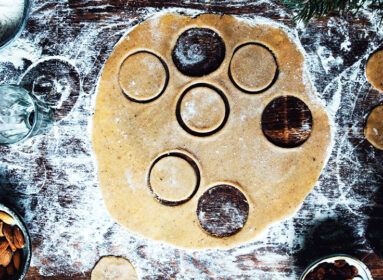The Pomegranate: A Rosh Hashanah Symbol
By Sybil Kaplan
Pomegranates are referred to in the Bible in many various ways. In the sensual poetry of Song of Songs, we read: “I went down into the garden of nuts…to see whether the vine budded, and the pomegranates were in flower” (Song of Songs 6:11). In another passage, the poet writes– “I would cause thee to drink of spiced wine, of the juice of my pomegranate” (Song of Songs 8:2). Song of Songs has four additional mentions of pomegranates, and there are also references in Joel, Haggai and I Kings.
For many Jews, pomegranates are traditional for Rosh Hashanah. Some believe the dull and leathery skinned crimson fruit may have really been the tapuach, apple, of the Garden of Eden. Originating in Persia, the pomegranate is one of the world’s oldest cultivated fruits, having been domesticated around 4000 B.C.E. The Egyptians imported pomegranates from the Holy Land in 1150 B.C.E., and natural pomegranate juice made into spiced wine was a favorite of Hebrews living in Egypt. Pomegranate wood could also be carved into skewers on which to roast the lamb for Passover.
The word pomegranate means “grained apple.” In Hebrew, it is called rimon (also the word for a hand grenade!). The Hebrews yearned for the pomegranates they left behind in Egypt while wandering in the desert: “And wherefore have ye made us to come up out of Egypt, to bring us in unto this evil place? It is no place of seed, or of figs, or of vines, or of pomegranates” (Numbers 20:5). And so it was the spies reported their findings in Canaan back to Moses-“And they came unto the valley Eshkol, and cut down from thence a branch with one cluster of grapes, and they bore it upon a pole between two; they took also of the pomegranates, and of the figs” (Numbers 13:23). “For the Lord thy God bringeth thee into a good land…a land of wheat and barley, and vines and fig-trees and pomegranates” (Deuteronomy 8:7-8). Thus pomegranate was one of the seven species of Eretz Yisrael.
We know pomegranate images were woven into the hems of the robes of the priests: “And beneath upon the hem of it thou shalt make pomegranates of blue, and of purple, and of scarlet, round about the hem thereof; and bells of gold between them round about” (Exodus 28:33). Pomegranates were also used on the faces of the shekel in the second century B.C.E. King Solomon had an orchard of pomegranates, and pomegranates of brass were part of the pillars of his great Temple in Jerusalem. Throughout the Bible, as seen from the quotations above, the pomegranates are referred to and became symbolic of fertility.
The tradition of kabbalah recounted that there were 613 seeds in each pomegranate, equaling the number of mitzvot commanded by God.
On the second night of Rosh Hashanah, when it is customary to eat a “new” fruit that has not been eaten during the year, many Jews choose pomegranate. Sephardic Jews recite the prayer “ken yehi ratzon-may it be thy will, O Creator, that our year be rich and replete with blessings as the pomegranate rich and replete with seeds.”
Last year, a study at the Technion Institute of Technology in Haifa showed the power of the fruit. The cholesterol oxidation process, which creates lesions that narrow arteries and result in heart disease, was slowed by as much as forty percent when health subjects drank two to three ounces of pomegranate juice a day for two weeks. The juice reduced the retention of LDL, the “bad” cholesterol that aggregates and forms lesions. When subjects stopped drinking the juice, the beneficial effects lasted about a month. Other studies showed that pomegranates fight inflammation and cancer and slow cellular aging. Pomegranates are a good source of potassium, low in calories and low in sodium.
When choosing a pomegranate, look for one that is large, brightly colored and has a shiny skin. Store a pomegranate in a plastic bag in the refrigerator and it can keep up to ten weeks. To open a pomegranate, score the outside skin into four pieces, and then break the fruit apart with your hands following the divisions of the membranes that separate the sections. Pull off membranes then scrape the seeds into your mouth or lift them out with a spoon.
POMEGRANATE RECIPES
Some years ago, a food columnist for the Jerusalem Post compiled a cookbook entitled “Pomegranates” with 64 recipes. Here is one recipe from that book and three of my own.
Celebration Salad with Pomegranates Poppy Seed Dressing
From “Pomegranates” by Ann Kleinberg
6-8 servings
8 cups mixed salad greens
2 heads Belgian endive, trimmed and coarsely chopped
1 red onion, thinly sliced into half rounds
1 avocado, peeled and cubed
2 navel oranges, peeled and cut into bite-size pieces, membranes removed
1 red grapefruit, peeled and cut into bite-size pieces, membranes removed
1 cup black olive rings
2 tablespoon poppy seeds
Place greens and endive in large serving bowl and add onion, avocado, orange and grapefruit pieces,olives and 1/2 cup of pomegranate seeds. Add poppy seeds to vinaigrette, shake and dress the salad. Toss gently and sprinkle the remaining pomegranate seeds on top.
Basic Vinaigrette with Pomegranate Juice
1/4 cup pomegranate juice
3 tablespoon white wine vinegar
3 tablespoon olive oil
2 tablespoon canola oil
1 tablespoon freshly squeezed lemon juice
4 teaspoon sugar
2 minced garlic cloves
1 1/2 teaspoon Dijon mustard
1/2 teaspoon salt
Pinch of fresh ground pepper
Combine ingredients in a small bowl and whisk well. Pour into cruet or screw-top jar. Shake before dressing a salad.
Pomegranate Mousse
6 servings
1 pound pomegranate pulp
sugar to taste
1 1/4 cups whipped cream
1 tablespoon gelatin (Kosher)
3 tablespoon orange or lemon juice
Puree pomegranate seeds in blender to equal 1 1/4 cups with juice or water. Add sugar to taste. Mix in whipped cream. Warm orange or lemon juice. Add gelatin (Kosher) and dissolve. Stir into mixture. Pour into soufflé dish and chill.
Sybil Kaplan is a journalist, cookbook author, food writer and lecturer with a radio spot on Israel’s only English-language Internet radio station. She lives in Jerusalem.








 Southern New England Jewish Ledger
Southern New England Jewish Ledger











Comments are closed.